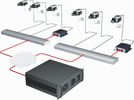

Thomas Probian, product manager for Bosch Security Systems, Germany, discusses the latest advances in network-based security and how these are making major contributions towards reducing bank fraud and other illegal activities.
Major changes in the business world engendered by today's `bandwidth revolution' are nowhere more evident than in the banking industry, where huge increases in available bandwidth are leading to what can only be described as a quantum leap in bank security.
By the nature of their business, banks are notoriously hard-headed organisations that will not readily invest in any project unless they can see a clear benefit for themselves and their customers. This, of course, is all to the good since it is our money they are entrusted with. Even in the area of security, they have traditionally been slow to invest in the latest systems, seeing them as peripheral to their core financial activities. This may seem something of a paradox, since banks are widely regarded as some of the most secure institutions in the world. And so they are. But new developments in the way we conduct financial transactions, especially the proliferation of automatic teller machines (ATMs), have dramatically increased the potential for bank fraud. This can be combated only through a reappraisal of bank-security measures to take advantage of newly available technologies.

Bandwidth is the key
Before the arrival of broadband communications, banks, like other business organisations, were severely limited in the amount of data they could transmit over their communication channels. ISDN could offer a maximum bandwidth of only 128 Kbps, which meant that all available bandwidth was devoted to financial traffic. Nothing was available for other activities like security, which then usually had to rely on standalone systems. Ten years ago a typical bank would have hold-up alarm buttons (which go back almost to the beginning of modern banking) and intrusion sensors. It would also have an analog CCTV surveillance system feeding a VCR located on the premises. You would seldom find fire alarms as these are a legal requirement only in venues designed to accommodate large numbers of people.
While standalone solutions were forced on banks by limited bandwidth, even today, with the Mbit/s bandwidths available through DSL (digital subscriber line) networks, banks still largely operate with standalone systems. This situation, however, is changing. With even small local banks in rural areas now being able to connect via DSL, banking chains are moving into broadband in a big way. And while most of this bandwidth is still devoted to financial traffic, the broadband infrastructure already installed still has enough in reserve for banks to put in place truly state-of-the-art security measures. Not all banking chains are moving in this direction yet, but it is anticipated that competitive pressure will soon see them doing so. Already where security is concerned, IT managers within the banks are becoming more heavily involved in the purchasing discussions with security companies. This, more than anything else, indicates the direction bank security is moving - which can only be good news for customers and bad news for potential lawbreakers.

Networked security
In Europe, more than half of CCTV surveillance systems used in banks are still standalone or even analog systems. With these systems, it is impossible to coordinate information from multiple sites since standalone CCTV systems are not connected to the outside world. What is more, since video tapes are continually re-used, image quality steadily degenerates until it becomes virtually unusable. Tape management and time-consuming searches are also major issues that have to be faced when trying to use this video evidence to resolve disputes or assist in criminal investigations.
Centralised digital systems have been slow in coming to the banking industry, but now, with the greater availability of bandwidth, these developments are expected to speed up. Modern digital technology offers a host of advantages to bank security, including the availability of a wide range of digital connectivity, viewing, recording, storage and control products.
Moreover, it is now generally accepted by the surveillance world that digital CCTV based on the internationally recognised Internet Protocol (IP) is the way ahead. With these systems, CCTV cameras and intrusion-alarm systems can be integrated into the network, each with its own IP address and all overseen and managed from a control centre, which may be located at the bank's central office. Once the network is established, plug-and-play functionality allows IP-enabled units to be easily added or removed. IP also allows easy implementation of 'intelligent' functionality in cameras, beginning with motion detection, but extending nowadays towards video content analysis, which compares realtime video with 'known rules' for detecting unknown events or behaviour. Typical applications of this in the banking environment could include suspicious behaviour recognition within the lobby of a bank and at ATMs and even facial recognition in the near future.
In place of the VCR, digital video recorders (DVRs) are also now available with hard disk drive capacities for many weeks of recording. The latest products on the market are capable of simultaneously processing many independent dual video streams. This enormous recording and transmission capability is possible only because the industry is already shifting to state-of-the-art compression technologies like MPEG-4. The video is transmitted via the network to the control centre where it can be monitored live on a bank of split-screen monitors, each displaying the video from several cameras. It is important to note here, however, that the recording is still done in the DVR at the local site, only the evaluation of live or recorded images from the control centre uses the bank's network and takes up bandwidth.
These new systems give authorised bank personnel fast, convenient access to the information they need to carry out their responsibilities with maximum effectiveness. They offer advanced features for viewing, with extremely flexible recording and image access. Communication and access is possible through the bank's private or DSL network, interfacing to a variety of peripheral devices and systems, which may be provided with additional security via VPN (virtual private network) technology. The systems provide full control of camera selection, sequencing and viewing modes to meet the needs of every situation. But the real power of these new DVRs is the quick, convenient accessibility to recorded images and information they provide, around the clock and on a global basis.
An example of such a system is the DiBos DVR/Transmission System. This has recently been enhanced by Bosch to include, in addition to a conventional interface for up to 30 analog video channels, an IP network interface for up to 32 network video and audio channels. This provides an easy upgrade path for banking organisations wishing to move to the more versatile IP-based systems whilst preserving their investment in existing analog systems. The DiBos system also uses the new MPEG-4 compression which combines superior image quality with high data storage efficiency, and it has sufficient hard-disk storage for up to three months of recording.
For IP-based systems, another solution for recording images has recently become available in the Network Video Recorder (NVR). This is a pure software solution that operates on standard platforms with an 'intelligent' server PC and a large number of hard disks. The NVR can record from any camera, at any distance, play back video and audio to any monitor, and support storage for up to 64 video channels.

ATM surveillance
Since their introduction in the 1970s, ATMs have dramatically expanded banking services by giving customers access to services 24 hours a day, every day of the year, rather than only during traditional banking hours. To provide additional convenience, most ATMs are connected to inter-bank networks such as Visa or MasterCard that enable customers to withdraw and even deposit money from any machines on the network.
With such systems, where there is no human supervision, fraud and theft are obvious potential problems. In particular, 'phantom withdrawals' from ATMs in which customers complain that the withdrawal was not made by them is a perennial problem that banks often attribute to fraud or mistakes by customers. To help combat this and resolve disputes, many banks today still use time-lapse CCTV with VCRs. However, this is inconvenient, especially in countries such as Germany where banks are required to store images for up to three months.
Here too, digital technology comes to the rescue. Not only is the storage and management of digital images much more convenient than dealing with VCR tapes, but digital technology allows the use of the latest data-recognition systems to trace all transactions at all cash points conducted through a particular customer's ATM card. This is the principle on which Bosch Security Systems' new 'ATM bridge' is based. This dedicated hardware/software solution provides an interface between the CCTV and ATM systems that stores a CCTV image of every transaction plus associated transaction data (account number, bank number, amount withdrawn, time and date). It allows all transactions and images of the person conducting the transactions to be reviewed. In many instances, these phantom withdrawals are found to be due to simple mistakes by customers (sometimes another family member using the ATM card without the owner's knowledge). And since banks are liable for any loss of their customers' money due to ATM theft, the investment in data-recognition systems can result in significant savings.

A competitive edge
Although migrating to network-based security systems will involve considerable investment, much of this investment is embodied in the new broadband infrastructure that the banking industry has already started to adopt. In pure financial terms it may be difficult to quantify the benefits that adopting this new technology will bring. However, the benefits in enhanced customer confidence will be incalculable, and will provide banks, especially those first to make the transition, with a real competitive edge.
| Tel: | +27 11 651 9600 |
| Email: | [email protected] |
| www: | www.boschsecurity.com/xf/en |
| Articles: | More information and articles about Bosch Building Technologies |

© Technews Publishing (Pty) Ltd. | All Rights Reserved.